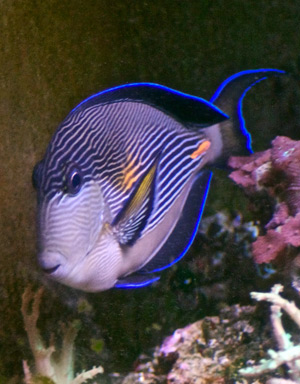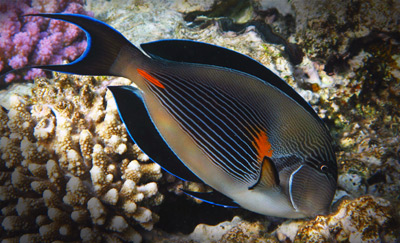The sohal tang (Acanthurus sohal) is one of many fish species available in the marine aquarium trade that should come with a warning label. It’s a gorgeous fish and generally very hardy, which is a plus, but anyone contemplating purchasing A. sohal should also be aware of its eventual size and often hyper-aggressive disposition.
Physical traits
A. sohal, which is found in the Western Indian Ocean, from the Red Sea to the Persian Gulf, is laterally compressed and ovoid in general shape. On its flanks and head, it exhibits narrow, horizontal, alternating light and dark stripes, which are vermiculated (wavy) around the head. The dorsal, anal, and pelvic fins are black while the pectoral and caudal fins are yellowish. All the fin margins are a striking neon blue. The location of the “scalpel” on the caudal peduncle—which, by the way, is very capable of inflicting severe lacerations on tankmates and careless aquarists’ hands—is highlighted in orange. The maximum size for this species is around 16 inches, though not all aquarium specimens will grow so large.
Feeding
The sohal tang is all herbivore. Offer it frequent daily feedings of algae-based foods, such as frozen herbivore formulations, herbivore pellets, and dried marine algae (e.g., the sushi nori or red marine algae sold in sheets). Of course, the sohal tang will also happily graze on various algae growing naturally within the system.
Housing
Don’t be fooled by the relatively small size at which A. sohal is commonly sold. It gets very big and needs appropriately large housing—a tank of at least 200 to 300 gallons in capacity. Also, this species is fast-moving and boisterous, so make sure there’s ample open swimming space to accommodate this behavior. The rockwork should be arranged such that there are abundant hiding places in which any tankmates can seek refuge in case they’re bullied.
Compatibility

Here’s where things can get really dicey. Sohals can be extremely territorial, and attempts to keep them in mixed communities sometimes prove disastrous. Some suggest adding them to an aggressive community of large, rough-and-tumble species. Others recommend housing them with much smaller species that won’t be perceived as competition for resources or a challenge to their dominance. However, I think it’s fair to say that this species isn’t entirely trustworthy in either case. Individual specimens can vary considerably in their temperament, plus it’s not unheard of for once well-behaved specimens to turn into unholy terrors as they mature.
The best advice I can give is to avoid conspecifics or any similar-looking species as tankmates, introduce the sohal last, and watch it very closely for signs of bad behavior. How’s that for fence riding?
With respect to inclusion in reef systems, A. sohal is generally a safe choice, though it may nip at fleshy coral polyps and clam mantles as it grazes throughout the system.



